Ampang and Sri Petaling lines
The LRT Ampang Line and the LRT Sri Petaling Line are light rapid transit (LRT) lines in the Klang Valley, Malaysia. The combined network comprises 45.1 kilometres of track (28.0 miles) with 36 stations, and is the first to use the standard gauge track and semi-automated trains in the Klang Valley.
| Ampang Line and Sri Petaling Line | |||
|---|---|---|---|
| 3 4 | |||
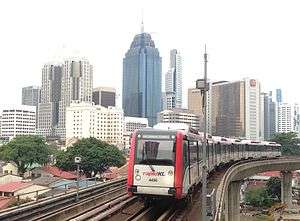 6-car CSR Zhuzhou Amy articulated LRV at SP4 PWTC | |||
| Overview | |||
| Native name | LRT Laluan Ampang dan LRT Laluan Sri Petaling | ||
| Type | Light rapid transit | ||
| Status | Fully operational | ||
| Locale | Klang Valley | ||
| Termini | AG1 SP1 Sentul Timur AG18 Ampang & SP31 Putra Heights | ||
| Stations | 36 & 2 reserve | ||
| Services | i) Sentul Timur - Ampang ii) Sentul Timur - Putra Heights | ||
| Daily ridership | 178,486 (2019)[1] | ||
| Ridership | 65.15 million (2019) | ||
| Line number | 3 (orange) & 4 (maroon) | ||
| Website | My Rapid | ||
| Operation | |||
| Opened | 16 December 1996 | ||
| Last extension | 30 June 2016 | ||
| Owner | |||
| Operator(s) | Rapid Rail | ||
| Character | Elevated and at-grade | ||
| Depot(s) | Ampang Depot & Kuala Sungai Baru Depot | ||
| Rolling stock | CSR Zhuzhou articulated LRV 50[2] six-car trainsets Width: 2.65 m (8 ft 8 in) Length: 84.0 m (275.6 ft) | ||
| Technical | |||
| Line length | 45.1 km (28.0 mi) | ||
| Track gauge | 1,435 mm (4 ft 8 1⁄2 in) standard gauge | ||
| Electrification | Third rail 750 V DC | ||
| Operating speed | Average: 60 km/h (37 mph) | ||
| Signalling | SelTrac CBTC | ||
| |||
3 - Ampang Line | ||||||||||||||||||||||||||||||||||||||||||||||||||||||||||||||||||||||||||||||||||||||||||||||||||||||||||||||||||||||||||||||||||||||||||||||||||||||||||||||||||||||||||||||||||||||||||||||||||||||||||||||||
|---|---|---|---|---|---|---|---|---|---|---|---|---|---|---|---|---|---|---|---|---|---|---|---|---|---|---|---|---|---|---|---|---|---|---|---|---|---|---|---|---|---|---|---|---|---|---|---|---|---|---|---|---|---|---|---|---|---|---|---|---|---|---|---|---|---|---|---|---|---|---|---|---|---|---|---|---|---|---|---|---|---|---|---|---|---|---|---|---|---|---|---|---|---|---|---|---|---|---|---|---|---|---|---|---|---|---|---|---|---|---|---|---|---|---|---|---|---|---|---|---|---|---|---|---|---|---|---|---|---|---|---|---|---|---|---|---|---|---|---|---|---|---|---|---|---|---|---|---|---|---|---|---|---|---|---|---|---|---|---|---|---|---|---|---|---|---|---|---|---|---|---|---|---|---|---|---|---|---|---|---|---|---|---|---|---|---|---|---|---|---|---|---|---|---|---|---|---|---|---|---|---|---|---|---|---|---|---|---|
| ||||||||||||||||||||||||||||||||||||||||||||||||||||||||||||||||||||||||||||||||||||||||||||||||||||||||||||||||||||||||||||||||||||||||||||||||||||||||||||||||||||||||||||||||||||||||||||||||||||||||||||||||
| ||||||||||||||||||||||||||||||||||||||||||||||||||||||||||||||||||||||||||||||||||||||||||||||||||||||||||||||||||||||||||||||||||||||||||||||||||||||||||||||||||||||||||||||||||||||||||||||||||||||||||||||||
4 - Sri Petaling Line | ||||||||||||||||||||||||||||||||||||||||||||||||||||||||||||||||||||||||||||||||||||||||||||||||||||||||||||||||||||||||||||||||||||||||||||||||||||||||||||||||||||||||||||||||||||||||||||||||||||||||||||||||||||||||||||||||||||||||||||||||||||||||||||||||||||||||||||||||||||||||||||||||||||||||||||||||||||||||||||||||
|---|---|---|---|---|---|---|---|---|---|---|---|---|---|---|---|---|---|---|---|---|---|---|---|---|---|---|---|---|---|---|---|---|---|---|---|---|---|---|---|---|---|---|---|---|---|---|---|---|---|---|---|---|---|---|---|---|---|---|---|---|---|---|---|---|---|---|---|---|---|---|---|---|---|---|---|---|---|---|---|---|---|---|---|---|---|---|---|---|---|---|---|---|---|---|---|---|---|---|---|---|---|---|---|---|---|---|---|---|---|---|---|---|---|---|---|---|---|---|---|---|---|---|---|---|---|---|---|---|---|---|---|---|---|---|---|---|---|---|---|---|---|---|---|---|---|---|---|---|---|---|---|---|---|---|---|---|---|---|---|---|---|---|---|---|---|---|---|---|---|---|---|---|---|---|---|---|---|---|---|---|---|---|---|---|---|---|---|---|---|---|---|---|---|---|---|---|---|---|---|---|---|---|---|---|---|---|---|---|---|---|---|---|---|---|---|---|---|---|---|---|---|---|---|---|---|---|---|---|---|---|---|---|---|---|---|---|---|---|---|---|---|---|---|---|---|---|---|---|---|---|---|---|---|---|---|---|---|---|---|---|---|---|---|---|---|---|---|---|---|---|---|---|---|---|---|---|---|---|---|---|---|---|---|---|---|---|---|---|---|---|---|---|---|---|---|---|---|---|---|---|---|---|---|---|---|---|---|---|---|---|---|---|---|---|---|---|---|---|---|---|
| ||||||||||||||||||||||||||||||||||||||||||||||||||||||||||||||||||||||||||||||||||||||||||||||||||||||||||||||||||||||||||||||||||||||||||||||||||||||||||||||||||||||||||||||||||||||||||||||||||||||||||||||||||||||||||||||||||||||||||||||||||||||||||||||||||||||||||||||||||||||||||||||||||||||||||||||||||||||||||||||||
| ||||||||||||||||||||||||||||||||||||||||||||||||||||||||||||||||||||||||||||||||||||||||||||||||||||||||||||||||||||||||||||||||||||||||||||||||||||||||||||||||||||||||||||||||||||||||||||||||||||||||||||||||||||||||||||||||||||||||||||||||||||||||||||||||||||||||||||||||||||||||||||||||||||||||||||||||||||||||||||||||
A trip from one end to another takes 41 minutes on the Ampang Line, and 74 minutes on the Sri Petaling Line.
The Ampang Line is named after its terminus, Ampang station, while the Sri Petaling Line is named after its former terminus, Sri Petaling station.
The Ampang and Sri Petaling Lines form part of the Klang Valley Integrated Transit System, numbered 3 and 4, and are coloured orange and maroon on official rail maps respectively.
History
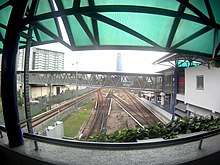
The Ampang Line and Sri Petaling Line were originally known as the STAR LRT (abbreviation for Sistem Transit Aliran Ringan, which translates to Light Rail Transit System), a single train line with two branches originating from Sentul Timur station and sprawling to Ampang and Sri Petaling stations via Chan Sow Lin station.
STAR LRT was first conceived in the 1981 Transport Master Plan, when the government proposed a network of LRT lines connecting the Kuala Lumpur city centre to the surrounding areas. An agreement was signed between the government and STAR in 1992.[3]
The original system (27.4 km) consists of 25 stations built in two phases. Phase one (12.4 km) consists of 14 stations (Ampang – Sultan Ismail) and a depot near Ampang station. Phase two (15 km) consists of 11 stations (Chan Sow Lin – Bukit Jalil, and Sultan Ismail – Sentul Timur). The two phases opened in December 1996 and July 1998.[4][5]
The initial plan was for STAR to build, own and manage the STAR LRT. However, STAR ran into financial difficulties, and had to be bailed out by the government.[6] So, in 2002, Prasarana took over the line, and renamed the STAR LRT to the STAR Line. Operations of the line were subsequently transferred to Rapid KL in 2004 and the line was renamed the Ampang Line and Sri Petaling Line in 2005. The Ampang Line assumed the branch line between Sentul Timur and Ampang stations, whereas Sri Petaling Line assumed the branch line between Sentul Timur and Sri Petaling stations.
In 2006, the government announced the Sri Petaling Line extension project. The extension comprises 11 new stations over 17.7 kilometres of elevated track beyond the Sri Petaling station. This extended the terminus of the Sri Petaling Line from Sri Petaling to Putra Heights.[7] Unlike the original line, which uses the Fixed-block signaling system, the extension uses the Communications-based train control (CBTC) signaling system. As a result, when the first four stations and the next four stations opened on 31 October 2015 and 31 March 2016, the extension ran as a separate train service between Sri Petaling station and Bandar Puteri station.[8][9]
Re-signaling had to be done on the original line, before the extension could be combined with the rest of the line. Thales was awarded a contract on 3 September 2012 to upgrade the signaling system on the original line, and the installation of the new signaling was completed in July 2016.[10][11]
Stations
The Ampang and Sri Petaling Lines run on a common route between Sentul Timur station and Chan Sow Lin station, effectively making all the stations on this section act as interchanges between both lines. From Chan Sow Lin station, the lines diverge and run separately, with the Ampang Line travelling to its terminus, Ampang station, whereas the Sri Petaling Line runs to Putra Heights station, where it meets the Kelana Jaya Line.[12][13]
LRT Ampang Line
| Code | Name | Platform type | Interchange/Notes |
| AG1 SP1 | Sentul Timur | Terminus (Side) | Northern terminus. |
| AG2 SP2 | Sentul | Side | |
| AG3 SP3 | Titiwangsa | Side | Interchange station with MR11 KL Monorail and future interchange with SSP13 MRT Putrajaya Line |
| AG4 SP4 | PWTC | Side | Pedestrian access to KA04 Putra for KTM Seremban Line and KTM Port Klang Line via a 600-metre link-bridge |
| AG5 SP5 | Sultan Ismail | Side | Pedestrian access to MR9 Medan Tuanku for KL Monorail |
| AG6 SP6 | Bandaraya | Side | Connecting station to KA03 Bank Negara for KTM Seremban Line and KTM Port Klang Line via a 250-metre link-bridge |
| AG7 SP7 | Masjid Jamek | Side | Interchange station with KJ13 LRT Kelana Jaya Line. |
| AG8 SP8 | Plaza Rakyat | Side | Interchange station to SBK17 Merdeka for MRT Kajang Line via a 180-metre air-conditioned covered walkway. |
| AG9 SP9 | Hang Tuah | Side | Interchange station with MR4 KL Monorail |
| AG10 SP10 | Pudu | Side | |
| AG11 SP11 | Chan Sow Lin | Island | Future interchange with SSP20 MRT Putrajaya Line |
| AG12 | Miharja | Side | |
| AG13 | Maluri | Side | Interchange station with the SBK22 MRT Kajang Line
|
| AG14 | Pandan Jaya | Side | |
| AG15 | Pandan Indah | Side | |
| AG16 | Cempaka | Side | |
| AG17 | Cahaya | Side | |
| AG18 | Ampang | Terminus (Island) | Eastern terminus. |
LRT Sri Petaling Line
| Code | Name | Platform type | Interchange/Notes |
| AG1 SP1 | Sentul Timur | Terminus (Side) | Northern terminus. |
| AG2 SP2 | Sentul | Side | |
| AG3 SP3 | Titiwangsa | Side | Interchange station with MR11 KL Monorail and as future interchange with SSP13 MRT Putrajaya Line |
| AG4 SP4 | PWTC | Side | Pedestrian access to KA04 Putra for KTM Seremban Line and KTM Port Klang Line via a 600-metre link-bridge |
| AG5 SP5 | Sultan Ismail | Side | Pedestrian access to MR9 Medan Tuanku for KL Monorail |
| AG6 SP6 | Bandaraya | Side | Connecting station to KA03 Bank Negara for KTM Seremban Line and KTM Port Klang Line via a 250-metre link-bridge |
| AG7 SP7 | Masjid Jamek | Side | Interchange station with KJ13 LRT Kelana Jaya Line. |
| AG8 SP8 | Plaza Rakyat | Side | Interchange station to SBK17 Merdeka for MRT Kajang Line via a 180-metre air-conditioned covered walkway. |
| AG9 SP9 | Hang Tuah | Side | Interchange station with MR4 KL Monorail |
| AG10 SP10 | Pudu | Side | |
| AG11 SP11 | Chan Sow Lin | Island | Future interchange with SSP20 MRT Putrajaya Line |
| SP12 | Cheras | Side | Feeder Bus T401 to SBK21 Cochrane for the MRT Kajang Line |
| SP13 | Salak Selatan | Side | Feeder Bus T402 to SBK24 Taman Midah for the MRT Kajang Line |
| SP14 | Bandar Tun Razak | Side | |
| SP15 | Bandar Tasik Selatan | Island | Interchange station, without paid area integration, to:
Feeder bus T410 to SBK26 Taman Connaught for the MRT Kajang Line |
| SP16 | Sungai Besi | Side | Future interchange with SSP25 MRT Putrajaya Line |
| SP17 | Bukit Jalil | Side | |
| SP18 | Sri Petaling | Side | |
| SP19 | Awan Besar | Island | |
| SP20 | Muhibbah | Side | |
| SP21 | Alam Sutera | Side | |
| SP22 | Kinrara BK5 | Side | |
| SP23 | Kinrara BK3 | - | Provisional station |
| SP24 | IOI Puchong Jaya | Side | |
| SP25 | Pusat Bandar Puchong | Side | |
| SP26 | Taman Perindustrian Puchong | Side | |
| SP27 | Bandar Puteri | Island | |
| SP28 | Puchong Perdana | Side | |
| SP29 | Puchong Prima | Side | |
| SP30 | Kampung Sri Aman | - | Provisional station |
| SP31 | Putra Heights | Terminus (Island & Side) | Southern terminus of both the LRT Kelana Jaya Line and LRT Sri Petaling Line.
|
Rolling stock
.jpg)
The rolling stock of the Ampang Line and Sri Petaling Line currently consists of a fleet of 50 new trains, better known as AMY, that are deployed to increase the capacity of the line and provide a better service. Each of the new trains is six cars long[14][15] and provided by CSR Zhuzhou of China, similar to on the design for İzmir Metro and Buenos Aires Underground 200 Series.[16] These trains are disabled-friendly and include safety features like closed-circuit TV, emergency breakable window, emergency ventilation fan, fire and smoke detection system and supervised automatic train operation system (SATO), and other elements such as interactive destination display inside the train, non-slipping seats, LCD infotainment, walk-through gangways, and a more spacious wheelchair space for the physically challenged.[17][18] The first trains were put into service on the Sri Petaling-Kinrara BK5 stretch in October 2015, and then until Putra Heights and Sentul Timur in July 2016, and finally the Ampang branch line in December 2016.[19]
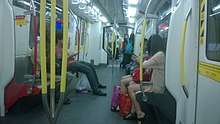
The former fleet consisted of 90 Adtranz standard-gauge light rail vehicle (LRV) manufactured by Walkers Limited of Australia. These trains were electric multiple units (EMU), which draw power from the underside of a third rail alongside the track. All cars in each train were powered. The trains were manned, with driver cabs occupying the ends of the train. The trainsets came in two configurations. The first and most common variation was the six-car trainset, which consisted of three sets of two EMUs (2+2+2) and occupied the maximum platform length of the stations. Each of the two EMU sets at the front and rear consisted of one driving car and one trailer car, while the two EMUs between were trailer cars. Each two EMU sets were not connected to other EMU sets in the train.
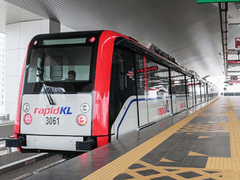
The second variation was a four-car trainset, a more obscure configuration that consists of only two EMU sets (2+2) of one driving car and one trailer car at both ends. These were only two-thirds the length and number of cars of the six-car variation. The 2+2 trainsets were used in full service until the widespread deployment of 2+2+2 trainsets. Each car had 3 bogies: 2 power bogies and one articulated trailer for the centre bogie. The end cars, numbered 1101 to 1260, have driver cabs. Middle cars numbered 2201 to 2230 have a concealed driver control panel, enabling the car to be moved around the depot independently. The train interiors were simple and basic. There were no individual seats, only longitudinal bench seating on either side of the train, surfaced in metal, while spaces near the connecting ends of the cars were provided for passengers who use wheelchairs and other assistive devices, with a large amount of floorspace for standing passengers. The rolling stock, which has remained relatively unchanged since its introduction in 1996, were replaced in stages by the new trains between 2015 and 2016.
The Ampang and Sri Petaling Lines system network fleet consists of the following models:
- 50 6-car CSR Zhuzhou articulated LRV trainsets, nicknamed as AMY, operated since January 2015.
- 29 + 1 (out of service) 6-car Adtranz-Walkers LRV trainsets, which were operated from December 1996 until December 2016, have been phased out and replaced by CSR Zhuzhou articulated LRV trainsets.
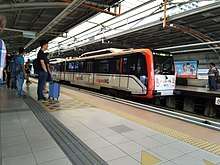
Formation
| Set designation | 1 | 2 | 3 | 4 | 5 | 6 |
|---|---|---|---|---|---|---|
| Formation | Cabin | Middle Car | Middle Car | Middle Car | Middle Car | Cabin |
| Set | 1 | 2 | 3 | 4 | 5 | 6 | Arrival date | Status | Launch date |
|---|---|---|---|---|---|---|---|---|---|
| AMY 1 | 3011 | 3012 | 3013 | 3014 | 3015 | 3016 | Jan 10 | In operation | 31 October 2015 |
| AMY 2 | 3021 | 3022 | 3023 | 3024 | 3025 | 3026 | Feb 28 | In operation | 31 October 2015 |
| AMY 3 | 3031 | 3032 | 3033 | 3034 | 3035 | 3036 | Mar 2015 | In operation | 31 October 2015 |
| AMY 4 | 3041 | 3042 | 3043 | 3044 | 3045 | 3046 | Apr 2015 | In operation | 31 October 2015 |
| AMY 5 | 3051 | 3052 | 3053 | 3054 | 3055 | 3056 | May 2015 | In operation | 31 October 2015 |
| AMY 6 | 3061 | 3062 | 3063 | 3064 | 3065 | 3066 | Jun 2015 | In operation | 31 October 2015 |
| AMY 7 | 3071 | 3072 | 3073 | 3074 | 3075 | 3076 | July 2015 | In operation | 31 October 2015 |
| AMY 8 | 3081 | 3082 | 3083 | 3084 | 3085 | 3086 | End July 2015 | In operation | 31 October 2015 |
| AMY 9 | 3091 | 3092 | 3093 | 3094 | 3095 | 3096 | August 2015 | In operation | 31 October 2015 |
| AMY 10 | 3101 | 3102 | 3103 | 3104 | 3105 | 3106 | In operation | ||
| AMY 11 | 3111 | 3112 | 3113 | 3114 | 3115 | 3116 | In operation | ||
| AMY 12 | 3121 | 3122 | 3123 | 3124 | 3125 | 3126 | In operation | ||
| AMY 13 | 3131 | 3132 | 3133 | 3134 | 3135 | 3136 | In operation | ||
| AMY 14 | 3141 | 3142 | 3143 | 3144 | 3145 | 3146 | In operation | ||
| AMY 15 | 3151 | 3152 | 3153 | 3154 | 3155 | 3156 | In operation | ||
| AMY 16 | 3161 | 3162 | 3163 | 3164 | 3165 | 3166 | In operation | ||
| AMY 17 | 3171 | 3172 | 3173 | 3174 | 3175 | 3176 | In operation | ||
| AMY 18 | 3181 | 3182 | 3183 | 3184 | 3185 | 3186 | In operation | ||
| AMY 19 | 3191 | 3192 | 3193 | 3194 | 3195 | 3196 | In operation | ||
| AMY 20 | 4201 | 4202 | 4203 | 4204 | 4205 | 4206 | In operation | ||
| AMY 21 | 4211 | 4212 | 4213 | 4214 | 4215 | 4216 | In operation | ||
| AMY 22 | 4221 | 4222 | 4223 | 4224 | 4225 | 4226 | In operation | ||
| AMY 23 | 4231 | 4232 | 4233 | 4234 | 4235 | 4236 | In operation | ||
| AMY 24 | 4241 | 4242 | 4243 | 4244 | 4245 | 4246 | In operation | ||
| AMY 25 | 4251 | 4252 | 4253 | 4254 | 4255 | 4256 | In operation | ||
| AMY 26 | 4261 | 4262 | 4263 | 4264 | 4265 | 4266 | In operation | ||
| AMY 27 | 4271 | 4272 | 4273 | 4274 | 4275 | 4276 | In operation | ||
| AMY 28 | 4281 | 4282 | 4283 | 4284 | 4285 | 4286 | In operation | ||
| AMY 29 | 4291 | 4292 | 4293 | 4294 | 4295 | 4296 | In operation | ||
| AMY 30 | 4301 | 4302 | 4303 | 4304 | 4305 | 4306 | In operation | ||
| AMY 31 | 4311 | 4312 | 4313 | 4314 | 4315 | 4316 | In operation | ||
| AMY 32 | 4321 | 4322 | 4323 | 4324 | 4325 | 4326 | In operation | ||
| AMY 33 | 4331 | 4332 | 4333 | 4334 | 4335 | 4336 | In operation | ||
| AMY 34 | 4341 | 4342 | 4343 | 4344 | 4345 | 4346 | In operation | ||
| AMY 35 | 4351 | 4352 | 4353 | 4354 | 4355 | 4356 | In operation | ||
| AMY 36 | 4361 | 4362 | 4363 | 4364 | 4365 | 4366 | In operation | ||
| AMY 37 | 4371 | 4372 | 4373 | 4374 | 4375 | 4376 | In operation | ||
| AMY 38 | 4381 | 4382 | 4383 | 4384 | 4385 | 4386 | In operation | ||
| AMY 39 | 4391 | 4392 | 4393 | 4394 | 4395 | 4396 | In operation | ||
| AMY 40 | 4401 | 4402 | 4403 | 4404 | 4405 | 4406 | In operation | ||
| AMY 41 | 4411 | 4412 | 4413 | 4414 | 4415 | 4416 | In operation | ||
| AMY 42 | 4421 | 4422 | 4423 | 4424 | 4425 | 4426 | In operation | ||
| AMY 43 | 4431 | 4432 | 4433 | 4434 | 4435 | 4436 | In operation | ||
| AMY 44 | 4441 | 4442 | 4443 | 4444 | 4445 | 4446 | In operation | ||
| AMY 45 | 4451 | 4452 | 4453 | 4454 | 4455 | 4456 | In operation | ||
| AMY 46 | 4461 | 4462 | 4463 | 4464 | 4465 | 4466 | In operation | ||
| AMY 47 | 4471 | 4472 | 4473 | 4474 | 4475 | 4476 | In operation | ||
| AMY 48 | 4481 | 4482 | 4483 | 4484 | 4485 | 4486 | In operation | ||
| AMY 49 | 4491 | 4492 | 4493 | 4494 | 4495 | 4496 | In operation | ||
| AMY 50 | 4501 | 4502 | 4503 | 4504 | 4505 | 4506 | In operation |
Train control
The Ampang and Sri Petaling Lines are equipped with the Thales SelTrac Communications-based train control (CBTC) signaling system, and the iVENCS Control Systems.[20][21][22][23]
The operations are controlled at the Ampang Operational and Control Centre, with different depots located at Ampang and Putra Heights.
Ridership
| Ampang/Sri Petaling Line Ridership[24] | |||
|---|---|---|---|
| Year | Ridership | Remarks | |
| 2019 | 65,147,222 | ||
| 2018 | 60,960,445 | ||
| 2017 | 59,462,032 | ||
| 2016 | 59,192,907 | ||
| 2015 | 62,809,412 | ||
| 2014 | 63,270,432 | ||
| 2013 | 60,207,397 | ||
| 2012 | 56,809,978 | ||
| 2011 | 53,568,672 | ||
| 2010 | 51,572,177 | ||
| 2009 | 49,375,077 | ||
| 2008 | 51,009,480 | ||
| 2007 | 52,434,883 | ||
| 2006 | 49,727,909 | ||
| 2005 | 45,636,997 | ||
| 2004 | 43,535,471 | ||
| 2003 | 41,159,817 | ||
| 2002 | 33,471,344 | ||
| 2001 | 32,412,191 | ||
| 2000 | 28,426,201 | ||
| 1999 | 22,829,543 | ||
References
- "Statistik Rel 2019" (PDF). Ministry of Transport (Malaysia). Archived from the original (pdf) on 22 April 2020.
- "Archived copy". Archived from the original on 25 July 2016. Retrieved 28 July 2016.CS1 maint: archived copy as title (link)
- An LRT-Bus strategy for greater Kuala Lumpur: What future integration?, page 9-10
- Trolley Wire, page 12-14
- Light Rail Transit Stations Archived 20 August 2017 at the Wayback Machine, page 4
- LRT to be bailed out, govt confirms
- "George Kent-Lion Pacific JV gets Ampang Line extension job". Archived from the original on 12 September 2017. Retrieved 7 May 2017.
- Month-long free ride at four new LRT stations – Prasarana
- Prasarana announces partial opening of Sri Petaling LRT line
- Thales awarded the contract to upgrade Kuala Lumpur Ampang Line to fully automated CBTC signalling
- Temporary suspension of LRT Ampang, Sri Petaling lines
- Wai, Kong (30 November 2016). "Direct LRT travel between Ampang and Sentul Timur starts tomorrow". Timeout.com. Retrieved 19 July 2017.
- "Direct LRT travel between Ampang and Sentul Timur from Thursday | New Straits Times | Malaysia General Business Sports and Lifestyle News". Nst.com.my. 29 November 2016. Retrieved 19 July 2017.
- "Prasarana: Ampang Line extension Phase 1 on track for October launch". Malay Mail. Kuala Lumpur. 7 March 2015. Retrieved 17 March 2015.
- "'Amy' to hit the tracks in October". The Star. Kuala Lumpur. 30 January 2015. Retrieved 17 March 2015.
- "CSR unveils new trains for KL Ampang Line". International Railway Journal. London. 4 March 2014. Retrieved 17 March 2015.
- Cheong, Sam (28 February 2014). "RapidKL gets 50 coaches for Ampang Line route". The Star. Kuala Lumpur. Retrieved 17 March 2015.
- "Ampang Line to get new trains in 2015". The Star. Kuala Lumpur. 21 October 2014. Retrieved 17 March 2015.
- "Direct LRT travel between Ampang and Sentul Timur from Thursday | New Straits Times | Malaysia General Business Sports and Lifestyle News". Nst.com.my. 29 November 2016. Retrieved 19 July 2017.
- Thales awarded the contract to upgrade Kuala Lumpur Ampang line to fully automated CBTC signalling
- Thales to supply CBTC for KL's Ampang Line
- Kelana Jaya Line Extension Opens
- "Thales to install CBTC signaling on Kuala Lampur's Ampang Line| Railway Technology". www.railway-technology.com/. Retrieved 26 March 2019.
- "Statistic of Rail Transport". Ministry of Transport (Malaysia).
External links
| Wikimedia Commons has media related to Ampang Line. |
